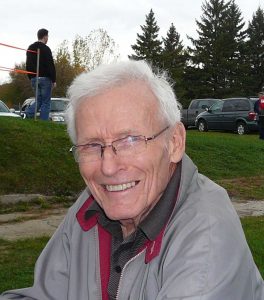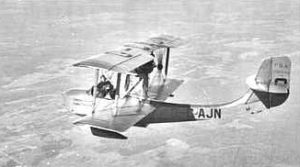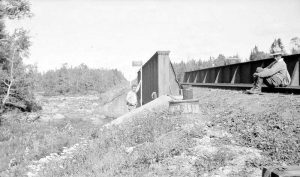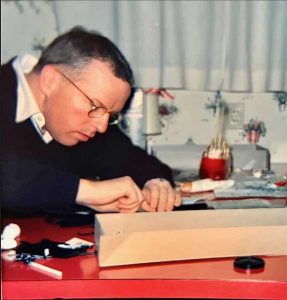Tribute November 17, 2022 — at Ste-Anne-de-Bellevue (Montréal)
On July 2, 2022, we lost one of our most respected Canadian aviation historians. George Fuller had a special interest in Québec aviation, and in early aviation generally. He shared his knowledge generously, and his recall was legendary as anyone who consulted him can attest.
The Canadian Aviation Historical Society Montréal Chapter will hold a tribute at their November 17, 2022 meeting, to take place at 11 a.m. at the Montréal Aviation Museum (MAM) on the McGill Macdonald Campus in Ste-Anne-de-Bellevue. If you plan to attend, please reserve by November 14 at cahsyulzoom@gmail.com. For Zoom reservations go to https://us02web.zoom.us/meeting/register/tZAqcu-srDIiGdPFXci2ANEH7I-RA8bsoATu
To view this article in your browser (recommended), click here: https://wp.me/p790K9-1xj
Link to biography of George Alexander Fuller: http://wp.me/P790K9-g0
Some Personal Recollections
My introduction to George Fuller came in 2013 through Bill Doran. Bill was associated with the Montréal Aviation Museum, and I knew him through mutual friends in the horsey world. I had written an article about a 1933 charter to Arctic Québec flown by my uncle Howard Watt, and when Bill received a copy he sent it on to George.
Right away, George decided to take me under his wing and educate me about Québec aviation. That was the beginning of many years of friendship.
Thanks to George, I was introduced to the CAHS Montréal Chapter, and joined this friendly and supportive group. Before long, George decided that I needed to see some Québec aviation sites in person. This led to a trip we made in 2015 to the Lower St. Lawrence in my Silverado truck. And thereby hangs a tale. Or two.
The Airport that Never Was
On our way to Sept-Îles, we stopped at Port-Cartier so I could take some photos at the Shelter Bay dam for my research. Uncle Howard lost his DH Dragon at this dam in 1941. A severe winter storm wrenched the biplane from its moorings on the ice and smashed it onto the rocks below the dam.
Once I had my photographs, we set off again in the truck, with George at the wheel. When he spotted a sign reading “Chemin de l’aéroport” – Airport Road, he just had to find this unknown airport.
It was a secondary road, not much travelled. There was nary a house or barn to be seen. After five or six kilometers, we came over the brow of a hill. Suddenly we found ourselves boxed in by high wire fencing with nowhere to go. What the heck? What airport ever had fencing like this?
A gate swung open and out came a black car full of men and women in uniform. As they sped off down the hill, uniformed guards appeared at our truck windows, wanting to know what on earth we were doing there. At a maximum-security prison. “Looking for an old airport?” A likely story!
Our explanations and apologies were finally accepted. But the ordeal was not over.
George still had to turn the truck around and get us out of there. There wasn’t much room, and he wasn’t used to the Silverado. You know that feeling when it’s as if you don’t know how to drive? A stream of cuss words helped, and after much toing and froing we were on the road again. You can bet your bottom dollar we never forgot that part of our trip!
This-A-Way or That-A-Way?
Another adventure came when George decided we should head into the backwoods of the South Shore to find a refueling base used in the 1920s by the Compagnie aérienne franco-canadienne (CAFC). This was the firm headed by Jacques de Lesseps, and back then it was engaged in major mapping contracts for the government of Québec using its Schreck FBA-17 flying boats.
Our destination, Lac Therrien, was definitely off the beaten track. To reach this remote paradise for cottagers and hiking enthusiasts, you travel 30 km south of Saint-Jean-Port-Joli on Route 204, half way to the Maine border.
From Tourville, a dirt road leads 12 km west to a small lake about 1.5 km long. Two signs greet you when you reach the T-intersection at the lake. Both sport arrows pointing to Lac Therrien. One little problem — the two signs point in opposite directions!
I jumped out of the driver’s seat to have a closer look, and George got out too, locking the truck behind him like a good city boy. Oh no! The keys were still in the ignition! There we were, stranded in the middle of nowhere. After a few minutes of abject misery, I remembered that blessed spare key I had taped inside the gas tank door many moons earlier.
Just then, a friendly man on a noisy quad came along. On hearing what we were looking for, he suggested we take the road to the west. At the end of the lake, the road petered out. Off to our left, sure enough, we spotted a railway embankment. Bingo!
George was as pleased as punch. This proved to be the Monk trunk line, part of the Canadian National Railway system which had opened up this area in 1919.
The find confirmed George’s views about the important connection between railways and early aviation in Canada. He reasoned that gas would have been brought in by rail at a location where the CAFC Schreck flying boats could set down. Here at Lac Therrien, it would have been an easy matter to offload the gas drums from the train and roll them less than 100 meters to the nearby grassy verge of the lake where the flying boats could be pulled ashore to gas up. We left feeling quite elated at the success of our detective work.
Banished from the Kitchen!
Once in a while, George would come for a visit at my farm. Do you remember how intense George could be when he got talking? He had this typical posture with one hand on his hip and he would lean towards you while he regaled you about his current project.
Needless to say, it was hard to cook when George launched into one of these tales while standing beside you in the kitchen. After I accidentally made a cake with no sugar, I laid down the law. Diana’s Kitchen Rule. George was absolutely forbidden to cross an imaginary line in the sand that separated the kitchen from the dining area! Of course, he forgot all the time …
Doting on Children
Those of you who knew George know that he loved aviation, and he loved his friends – but did you know how much he loved children? He absolutely doted on his sister’s great-grandchildren, always wanting the latest photos of the little girls.
His godson, Ken Stewart, and Ken’s brother Peter have happy memories of the many Christmas holidays that George spent in Montréal as a guest of their parents, Royal and Nancy Stewart. For the four Stewart children, the highlight of those visits was the time spent constructing models – mostly of aircraft, of course – with George leading the way in his patient and attentive manner.
And George’s cousin Jennifer Haney remembers him as someone who always made a point of visiting family members and old family friends whenever he went back to his home town of Sherbrooke.
Covid Brought Isolation
Covid was very hard on George, as on many elder seniors. He took the threat very seriously and became almost a hermit. The phone was his lifeline. He kept in touch with friends through regular calls, but on many days I was the only friend he spoke with, when he made his regular 7:30 evening call. On July 2 last summer, he surprised me by phoning at 9:30 a.m. He was quite excited about something and eager to talk. “Do you want to talk right now?” I asked. “No, I have things to do now. I’ll call you at the usual time this evening.” Fate intervened, as we know. I’m still waiting for that phone call …
A Time to Remember
As we pause in a silent moment on November 11 to remember all the men and women who have served and continue to serve our country during times of war, conflict and peace, let us give a special thought to the memory of George Alexander Fuller, who was proud to have served in the RCAF Auxiliary 1952-1958.










DIANA
WONDERFUL TRIBUTE
LOOKING FWD TO YOUR WINNIPEG EULOGY
BEST
ROBERT GALWAY
Thanks, Bob. I’ve been invited to speak about George Fuller’s legacy as an aviation historian. Will see you in Winnipeg – and look forward to your talk on early Canadian commercial aviation at the aviation conference in Winnipeg April 14-15.
Diana
What a wonderful tribute, I enjoyed so much reading this and thinking back to our time with “Uncle George”. Generous to fault and a truly kind and unique individual. We were so lucky to have him in our lives.
I adored Uncle George!! He played a big part in my childhood and set the bar for how I imagined I wanted to be in my life… it was his body language, his relaxed nature. his caring, his attention to details, his good nature and humour, his laugh and the wink he would give you to let you know you were doing good! I hope I ended up with just a few of those characteristics… rest in peace, Uncle George.
I met George only a few times, but I was taken by his intense interest in Canadian aviation. His interest in Quebec aviation was thorough. I missed the announcement of his death, but appreciate the reckoning here.